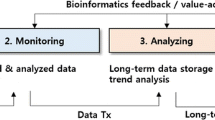Abstract
The researches for collecting personal daily behaviors and providing lifelog services with them have been recently increasing. Recent advances in mobile devices and sensor technologies have motivated to collect a huge amount of personal lifelog data in real time. With the rapid growth of the need for the research, there is a coming need for the effective lifelog management system which collects time-series big lifelog data sent from sensing devices and extracts major activities through processing them. For the effective lifelog management, the lifelog data can be processed in separated computing resources depending on the size and level of data. In this paper, we propose hierarchical structured data logging to support lifelog based personal services and to reduce the processing complexity and storage cost. First, we present the architecture of personal lifelog management system. With the system we present hierarchical lifelog data logging to optimally utilize computing and storage resources. Then we describe cost analysis and performance comparison for demonstrating the efficacy of our proposed system. Finally, as an initial step for experiments in our research, we describe experimental results of recognizing physical activities and extracting lifelog data which indicate major activities from them.









Similar content being viewed by others
References
Ahmed M, Hoang HH, Karim MS, Khusro S, Lanzenberger M, Latif K, Michlmayr E, Mustofa K, Nguyen HT, Rauber A, Schatten A, Tho MN, Tjoa AM (2004) SemanticLIFE: a framework for managing information of a human lifetime. In Proceedings 6th International Conference on Information Integration and Web-Based Applications and Services 183:725–734
Aris A, Gemmell J, Lueder R (2004) Exploiting Location and Time for Photo Search and Storytelling in MyLifeBits. Microsoft Research Technical Report, MSR-TR-2004-102
Blum S, Pentland A, Tröster G (2006) InSense: interest-based lifelogging. IEEE MultiMedia 13:40–48
Byrne D, Doherty AR, Snoek CGM, Jones G, Smeaton AF (2009) Everyday concept detection in visual lifelogs: validation, relationships and trends. Multimed Tools Appl J 49:119–144
Byungsang K, Chan-Hyun Y, Yong-Sung P, Yonggyu L, Wan C (2012) An adaptive workflow scheduling scheme based on an estimated data processing rate for next generation sequencing in cloud computing. J Inf Process Sys 8(4):555–566
Chen Y, Jones GJF (2010) Augmenting Human Memory using Personal Lifelogs. In Proceedings of the 1st Augmented Human International Conference, pp. 1–9
Dickie C, Vertegaal R, Fono D, Sohn C, Chen D, Cheng, Shell JS, Aoudeh O (2004) Augmenting and sharing memory with eyeBlog. In Proceedings of 1st ACM Workshop on Continuous Archival and Retrieval of Personal Experiences, pp. 105–109
Doherty AR, Caprani N, OConaire C, Kalnikaite V, Gurrin C, O’Connor Noel E, Smeaton Alan F (2011) Passively recognising human activities through lifelogging. Comput Hum Behav 27(5):1948–1958
Doherty AR, Smeaton AF (2010) Automatically augmenting lifelog events using pervasively generated content from millions of people. Sensors 10:1423–1446
Dumais S, Cutrell E, Cadiz J, Jancke G, Sarin R, Robbins D (2003) Stuff I’ve Seen: A System for Personal Information Retrieval and Re-Use. In Proceedings of the ACM Conference on Information Retrieval, pp. 72–79
Gemmell J, Bell G, Lueder R (2006) MyLifeBits: a personal database for everything. Commun ACM - Personal Inf Manag 49:88–95
Hodges S, Berry E, Wood K (2011) SenseCam: a wearable camera that stimulates and rehabilitates autobiographical memory. Memory 19(7):685–696
Hodges S, Williams L, Berry E, Izadi S, Srinivasan J, Butler A, Smyth G, Kapur N, Wood K (2006) SenseCam: A retrospective memory aid. In Proceedings of 8th International Conference on Ubiquitous Computing 4206:177–193
Kee-Yin Ng J (2012) Ubiquitous healthcare: healthcare systems and applications enabled by mobile and wireless technologies. J Converg 3(2):15–20
Latif K, Tjoa AM (2006) Combining context ontology and landmarks for personal information management. In Proceedings of International Conference on Computing and Informatics, pp. 1–6
Lee H, Smeaton AF, O’Connor NE, Jones G, Blighe M, Byrne D, Doherty AR, Gurrin C (2008) Constructing a SenseCam visual diary as a media process. Multimedia Sys 14:341–349
Minkyung Kim, Dong-Wook Lee, Kangseok Kim, Jai-Hoon Kim (2013) Analyzing Behavior Patterns with Lifelog Data in Ubiquitous Computing Environments. In Proceedings of FTRA International conference on Advanced IT, engineering and Management, pp. 105–106
Minkyung Kim, Dong-Wook Lee, Kangseok Kim, Jai-Hoon Kim, We-Duke Cho (2012) Predicting Personal Information Behaviors with Lifelog Data. In Proceedings of CEWIT International Conference, pp. 77–79
Sultana S, Karim R, Shahriyar R, MdM A, Ahamed SI (2009) Ubiquitous secretary: a ubiquitous computing application based on Web services architecture. Int J Multimed Ubiquit Eng 4(4):53–70
Teruhiko T (2012) Organization and exploration of heterogeneous personal data collected in daily life. Human-centric Comput Inf Sci 2(1):1–15
Whittaker S, Tucker S, Swampilla K, Laban R (2008) Design and evaluation of systems to support interaction capture and retrieval. Pers Ubiquit Comput 12:197–221
Acknowledgments
This research is supported by Basic Science Research Program through the National Research Foundation of Korea (NRF) funded by the Ministry of Education, Science and Technology (NRF- 2012R1A1A2A10041537).
Author information
Authors and Affiliations
Corresponding author
Rights and permissions
About this article
Cite this article
Kim, M., Lee, DW., Kim, K. et al. Hierarchical structured data logging system for effective lifelog management in ubiquitous environment. Multimed Tools Appl 74, 3561–3577 (2015). https://doi.org/10.1007/s11042-013-1671-x
Published:
Issue Date:
DOI: https://doi.org/10.1007/s11042-013-1671-x




